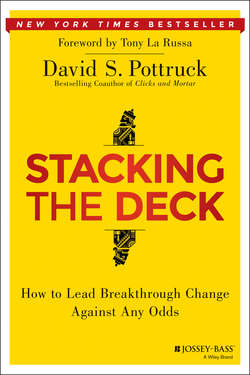Читать книгу Stacking the Deck - Pottruck David S. - Страница 9
На сайте Литреса книга снята с продажи.
Introduction
A Guide to Stacking the Deck
ОглавлениеThe book is divided into two parts. Part describes the Stacking the Deck process, nine steps through which nearly every breakthrough change inevitably goes. They're presented in the order in which you should undertake them, though there are exceptions. The steps often overlap, and circumstances frequently demand that you double back to repeat or redo a previous step in the process. Change is not linear and nothing about this should throw you off your game plan.
1. Step One is establishing the need to change and creating a sense of urgency around that need. Not only is this step critical – it's critically positioned. Much of the Stacking the Deck process focuses on the psychological aspects of change. Making the change necessary and urgent in the minds of those most affected by it is the social and emotional foundation for everything that comes afterward.
2. Step Two focuses on recruiting and unifying your inner team of innovation leaders who will help you define the future and make it a reality.
3. Step Three requires that you develop and communicate a clear and compelling vision of the future. This is the task that your new innovation leadership team must own.
4. Step Four enables you to anticipate, understand, and plan to overcome potential barriers to success. Some will always surprise you – but you can plan to deal with the ones you can anticipate.
5. Step Five describes how to develop a clear, executable plan that answers all the big questions a given change poses, while still recognizing the uncertainty and risk involved with undertakings of this magnitude.
6. Step Six explains how to break the change initiative into manageable pieces to build momentum and exponentially increase your chances of success.
7. Step Seven discusses defining metrics, developing analytics, and the importance of actively sharing your results, posting them as motivational tools to further build momentum. The possibilities and opportunities presented by big data are discussed in relation to leading breakthrough change.
8. Step Eight builds on the earlier Step Two principles for building the inner team and addresses the need for assessing, recruiting, and empowering the broader team.
9. Step Nine covers the power of pilot implementations and the critical differences between proof-of-concept pilots and scalability pilots.
Together these nine steps represent a plan of action that will take you from the first realization that a change needs to be made through a complete shift in the way you implement this change. This process is a practical guide you can use as you initiate and lead the change process. The questions and action items at the end of each chapter in Part are designed to guide you through the process and serve as a mental review whenever you are working through big transitions.
Part turns to the higher-order skills that are necessary for success in the process of leading breakthrough change. Chapter 10 describes the sequencing of the steps and provides practical advice on the final implementation and rollout process by which you bring the initiative to the real world. Chapter 11 focuses on developing leadership communication skills and the ability to be more inspirational, both of which are foundational to the entire Stacking the Deck process. The final chapter and the epilogue look at innovation and change leadership in general.
A caveat: this book is not about how to create innovative ideas and strategies. Its purpose is to show you how to implement the transformative concept that is described within. Stacking the Deck provides a wealth of examples born of my own and others' experience, stories that are intended to help you bridge the gap between idea and reality as you lead change.
